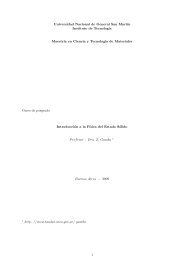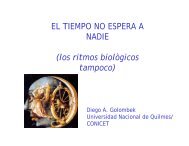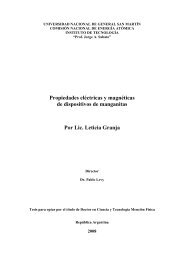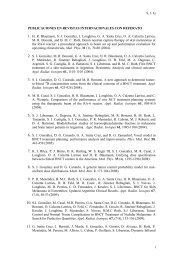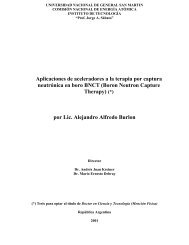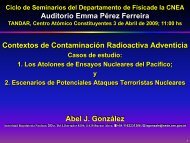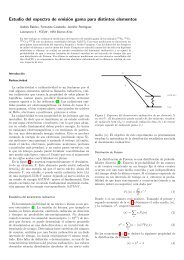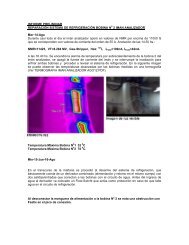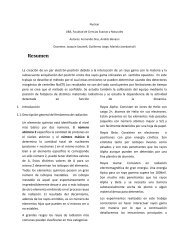Familia de Mapas del Panadero Como Ambiente Caótico de la ...
Familia de Mapas del Panadero Como Ambiente Caótico de la ...
Familia de Mapas del Panadero Como Ambiente Caótico de la ...
Create successful ePaper yourself
Turn your PDF publications into a flip-book with our unique Google optimized e-Paper software.
CAPÍTULO 5. CAMINATA ACOPLADA A PANADERO 58<br />
distancia variacional clásica<br />
distancia variacional clásica<br />
1.4<br />
1.3<br />
1.2<br />
1.1<br />
1.0<br />
0.9<br />
0.8<br />
0.7<br />
0.6<br />
0.5<br />
0.4<br />
0.3<br />
0.2<br />
0.1<br />
0.0<br />
B (Baker)<br />
6,1<br />
B<br />
6,2<br />
B<br />
6,3<br />
B<br />
6,4<br />
B<br />
6,5<br />
B (Many Coins)<br />
6,6<br />
0 20 40 60 80 100 120<br />
t<br />
140 160 180 200 220 240<br />
1.8<br />
1.6<br />
1.4<br />
1.2<br />
1.0<br />
0.8<br />
0.6<br />
0.4<br />
0.2<br />
1 qubit<br />
2 qubits<br />
3 qubits<br />
4 qubits<br />
5 qubits<br />
6 qubits<br />
7 qubits<br />
0.0<br />
0 20 40 60 80 100 120 140 160 180 200 220 240<br />
t<br />
Distancia Variacional Clásica<br />
distancia variacional clásica<br />
1.5<br />
1.4<br />
1.3<br />
1.2<br />
1.1<br />
1.0<br />
0.9<br />
0.8<br />
0.7<br />
0.6<br />
fam 1 (Baker)<br />
fam 2<br />
0.5<br />
fam 3<br />
0.4<br />
fam 4<br />
0.3<br />
fam 5<br />
0.2<br />
fam 6<br />
0.1<br />
0.0<br />
fam 7 (Many Coins)<br />
0 20 40 60 80 100 120 140<br />
t<br />
160 180 200 220 240<br />
1.8<br />
1.7<br />
1.6<br />
1.5<br />
1.4<br />
1.3<br />
1.2<br />
1.1<br />
1.0<br />
0.9<br />
0.8<br />
0.7<br />
0.6<br />
2 qubits<br />
3 qubits<br />
0.5<br />
4 qubits<br />
0.4<br />
5 qubits<br />
0.3<br />
6 qubits<br />
0.2<br />
0.1<br />
0.0<br />
7 qubits<br />
0 20 40 60 80 100 120 140 160 180 200 220 240<br />
t<br />
Figura 5.4: Distancia variacional clásica <strong>de</strong>l caminante acop<strong>la</strong>do al pana<strong>de</strong>ro en <strong>la</strong> línea infinita para<br />
<strong>la</strong> familia <strong>de</strong> 6 qubits y 7 qubits (arriba); y para varias monedas in<strong>de</strong>pendientes y el mapa <strong>de</strong>l pana<strong>de</strong>ro<br />
convencional (abajo). En todos los casos el caminante se encontraba localizado en posición y el estado<br />
inicial <strong>de</strong>l pana<strong>de</strong>ro era el “simétrico”.<br />
5.5. Varianza<br />
<strong>Como</strong> ya vimos en el capítulo <strong>de</strong> <strong>la</strong> caminata cuántica, <strong>la</strong> varianza <strong>de</strong>l caminante es una <strong>de</strong><br />
<strong>la</strong>s medidas que nos permite analizar su comportamiento.<br />
Todos los cálculos en este capítulo se realizarán para el caminante en <strong>la</strong> línea infinita con<br />
estado inicial localizado en posición.<br />
Po<strong>de</strong>mos notar en <strong>la</strong> figura 5.3 que a tiempo cortos (<strong>de</strong>l or<strong>de</strong>n <strong>de</strong><br />
log 2(N) = ♯ qubits) <strong>la</strong> caminata clásica y los miembros <strong>de</strong> <strong>la</strong> familia <strong>de</strong> <strong>la</strong> caminata acop<strong>la</strong>da al<br />
pana<strong>de</strong>ro se comportan <strong>de</strong> manera simi<strong>la</strong>r en distribución <strong>de</strong> probabilida<strong>de</strong>s. Esto también se<br />
pue<strong>de</strong> apreciar en <strong>la</strong> varianza don<strong>de</strong> para todos los caminantes se obtiene un comportamiento<br />
<strong>de</strong> tipo √ t.<br />
A partir <strong>de</strong> cierto tiempo el comportamiento <strong>de</strong> <strong>la</strong> varianza es linael para todos los caminantes<br />
cuánticos.



